The stunning set for Yang Liping Contemporary Dance’s Under Siege, on display as audiences trooped in to Lincoln Center’s David H. Koch Theater last weekend, would have staggered even the most jaded theater-goer. It was constructed of oversized silvery shears, thousands of them dangling ominously from an undulating lighting grid, their blades open. A persistent low jangling issued from the canopy of shears as breezes rustled the billowing structure.

Yang Liping Contemporary Dance in Yang Liping’s (Photo: Ding Yi Jie)
A constant presence onstage was a character known as the Paper Cutter – the marvelously serene Wang Yan. Clad in white, she sat amid a mound of white paper which framed her like a giant tutu. Wielding a mighty pair of scissors, she painstakingly cut out large Chinese characters from sheet after sheet.
Before events got underway, a foghorn boomed and the Paper Cutter held aloft a cut-out character. The translation – ‘Silence’ – popped up on TV monitors mounted on either side of the proscenium. This was followed by the obedient rustle of a thousand hands reaching into pockets and purses to silence electronic devices.
Never have I witnessed a more effective pre-show announcement. That moment was emblematic of the impact of this monumental work.
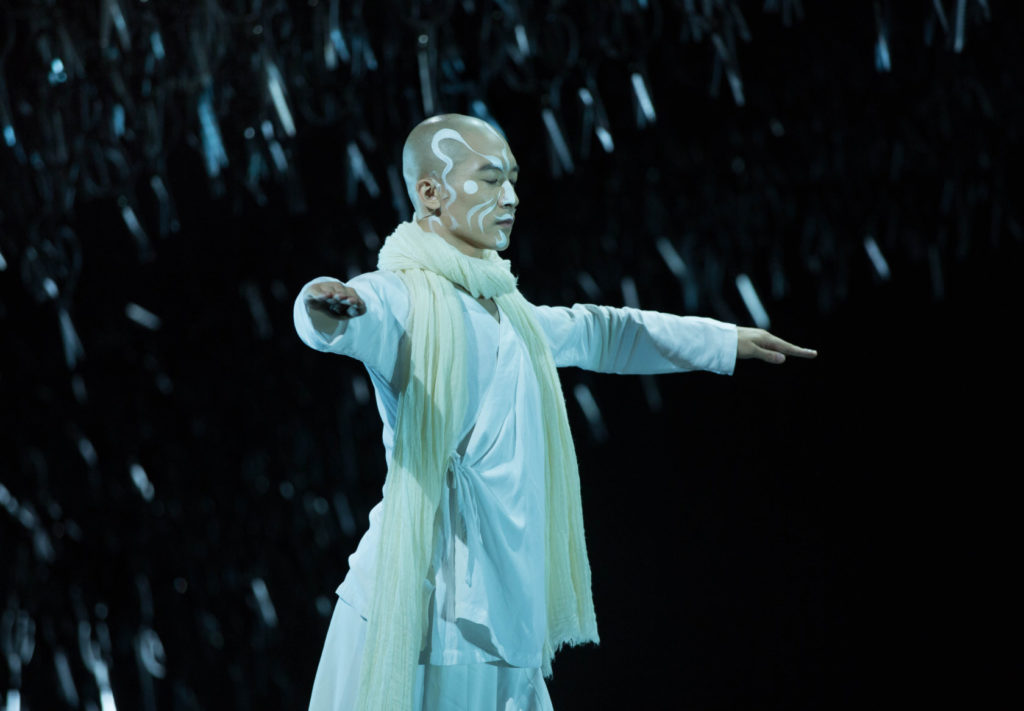
Yang Liping Contemporary Dance in Yang Liping’s Under Siege (Photo: Li Yi Jian)
Under Siege is a theatrical meditation on the war that launched the Han Dynasty (a subject treated most famously in the classic Beijing opera Farewell My Concubine.) This production touched down in New York at a time of heightened U.S.-China tensions, when Beijing, already grumpy over Donald Trump’s inability to grasp the basics of world trade, has accused the U.S. of masterminding massive street protests in Hong Kong.
Chinese propaganda arms have labeled the protests “terrorism” and whipped up public outrage on the mainland against the protestors. Observers fear another tragedy on the scale of Tiananmen Square, as outbreaks of violence have tarnished the largely peaceful protests, and PLA armored vehicles have amassed in Shenzhen, barely six kilometres from the Hong Kong border crossing.
Yang Liping is an acclaimed interpreter and champion of traditional dances of the Bai ethnic minority from her native province of Yunnan. She also happens to be a popular judge on So You Think You Can Dance China. Yang has said that she wanted Under Siege to convey “how people fight and destroy themselves in order to get more power, more money, how they lie to get the power and what the temptations are that leaders have to face and overcome.”
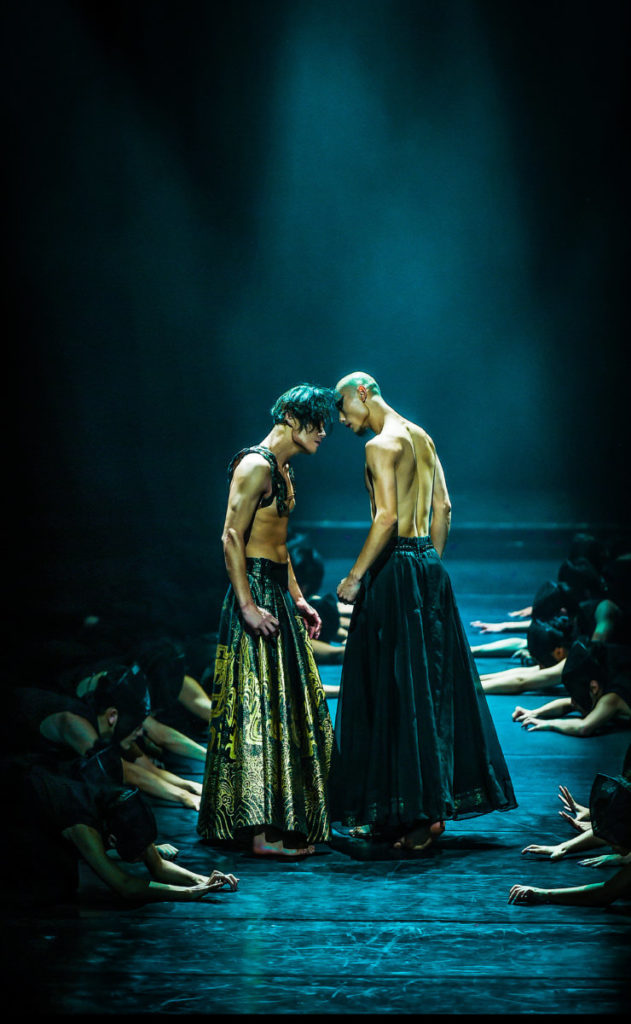
Yang Liping Contemporary Dance in Yang Liping’s (Photo: Ding Yi Jie)
The stylized brutality of the battles between war lords Xiang Yu (the fiery Ge Junyi) and Liu Bang (the smooth Zhu Fengwei) is depicted through an explosive hybrid of martial arts, contemporary, folk and street dance. Ge and Zhu spent much time flying through the air in spectacular 540 roundhouse kicks and back flips but they also conducted negotiations rife with subtle feints and undulating movements that evoked psychological warfare. Their warriors – fearless men and women in black vests, flowing black trousers and black helmets like carapaces – were a scheming bunch: when not clashing, they were busy spying on and double-crossing each other. (That the dancers were able to engage in combat without impaling themselves on the hanging blades was a feat in itself.)
Liu was apparently the craftier of the two rival leaders and, despite his more meager resources, managed to outsmart Xiang. Yet our sympathies may have inclined toward Xiang, heroic in defeat. Though Xiang was described in program notes as “an ambitious tyrant,” few could fail to be touched by the humanity displayed in his doomed relationship with concubine Yu Ji.

Yang Liping Contemporary Dance in Yang Liping’s (Photo: Ding Yi Jie)
Certain Beijing opera traditions were upheld: in the vocal and dramatic style of the narrator, for example, and in the cross-gender casting of the concubine. Dueling pipa players floated on and off stage as if by magic, producing a bewitching array of sounds from their instruments that were augmented by a ferocious percussionist in the pit – and by chunks of electronic music that seemed rather unnecessary.
Narrator Tong Mingguang, identified as the “statesman” Xiao He, sang with remarkable virtuosity, giving us more color commentary than play-by-play. But the broad outlines of the narrative were clear enough, as the Paper Cutter would occasionally brandish intricately shaped characters that tersely announced a new development, before allowing them to drift back down into the pile of paper around her.
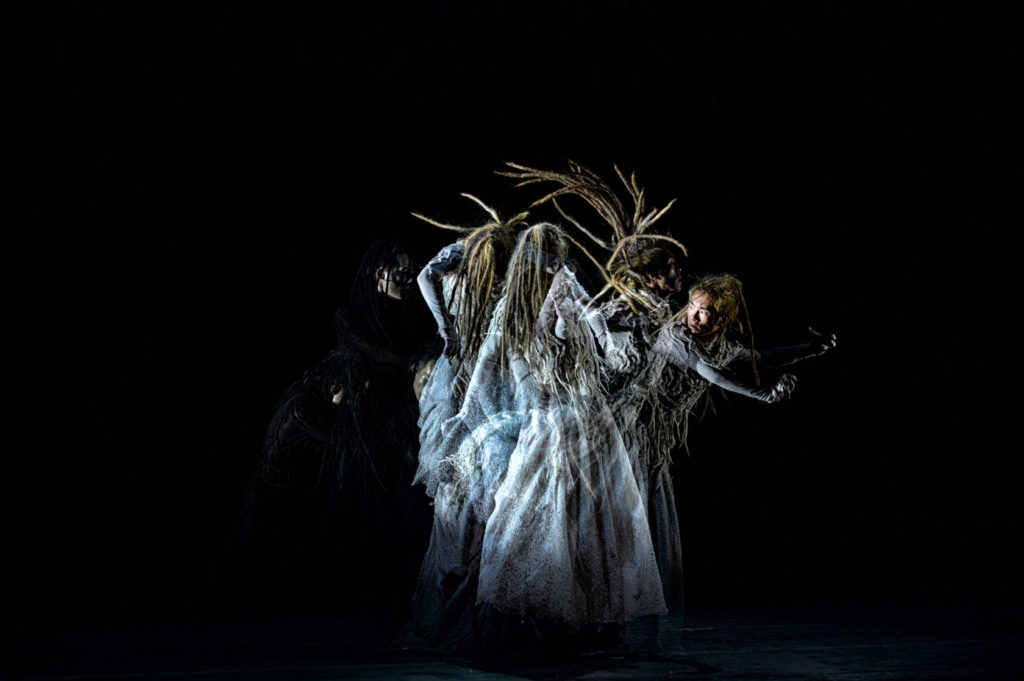
Yang Liping Contemporary Dance in Yang Liping’s Under Siege (Photo: Ma Hong Bo)
Choreography and design – the latter courtesy of designer Tim Yip, of Crouching Tiger fame, visual artist Beili Liu, and lighting genius Fabiana Piccioli – were more preoccupied with depicting psychological landscapes than with the timeline of events. Hence the schizophrenic character of Han Xin, Liu’s “brilliant but underappreciated general,” depicted by two constantly bickering dancers – one clad in white with chalk-white face, the other in black. This was a tired trope.
Another was the solo by Xiang’s concubine, danced by Hu Shenyuan, who first appeared onstage clad only in a flesh-colored dance belt and bathed in a golden light. He would later don a diaphanous gown but not before flaunting his extreme flexibility and elegant pointed feet in a slinky, come-hither solo. I found his simpering manner and exaggerated feline grace to be out of step with the modern dramatic sensibility adopted by the male protagonists – and by the female dancers in the warrior roles, who did not try to project stereotypical male attributes but let the choreography speak for itself. The tender, erotic duet between the concubine and her warrior lover, on the other hand, projected a devastating candour.
Their subsequent double suicide was enacted in a surreal setting of almost unbearable beauty. The Paper Cutter held up Chinese characters to signify “death and remembering” as the stage was flooded with scarlet feathers; these washed over the war dead and were kicked up in furious storms by the survivors.
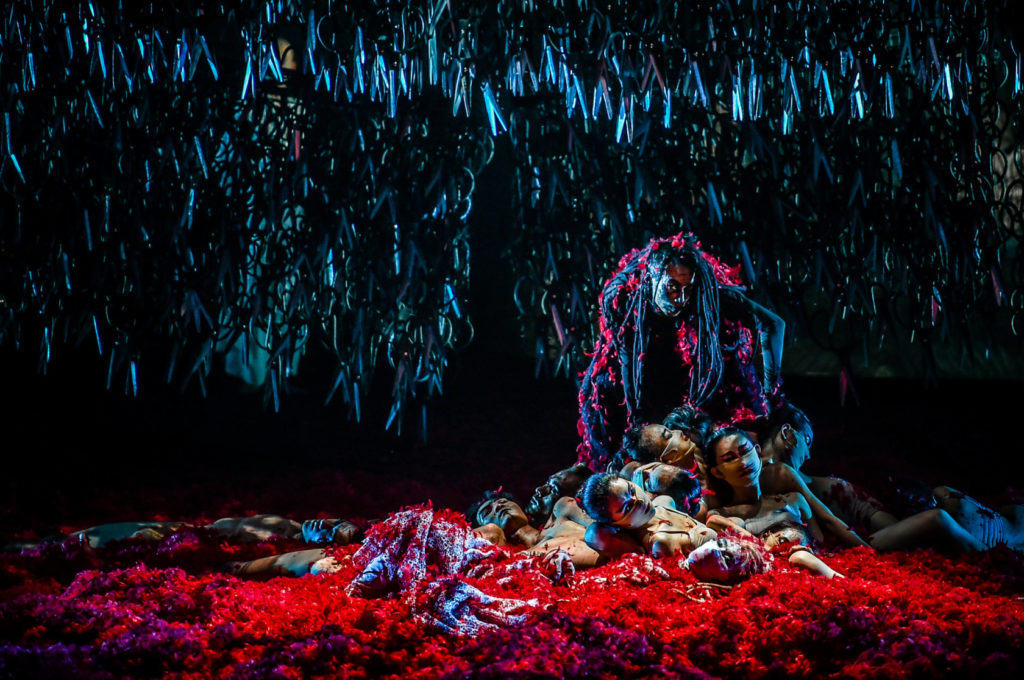
Yang Liping Contemporary Dance in Yang Liping’s (Photo: Ding Yi Jie)
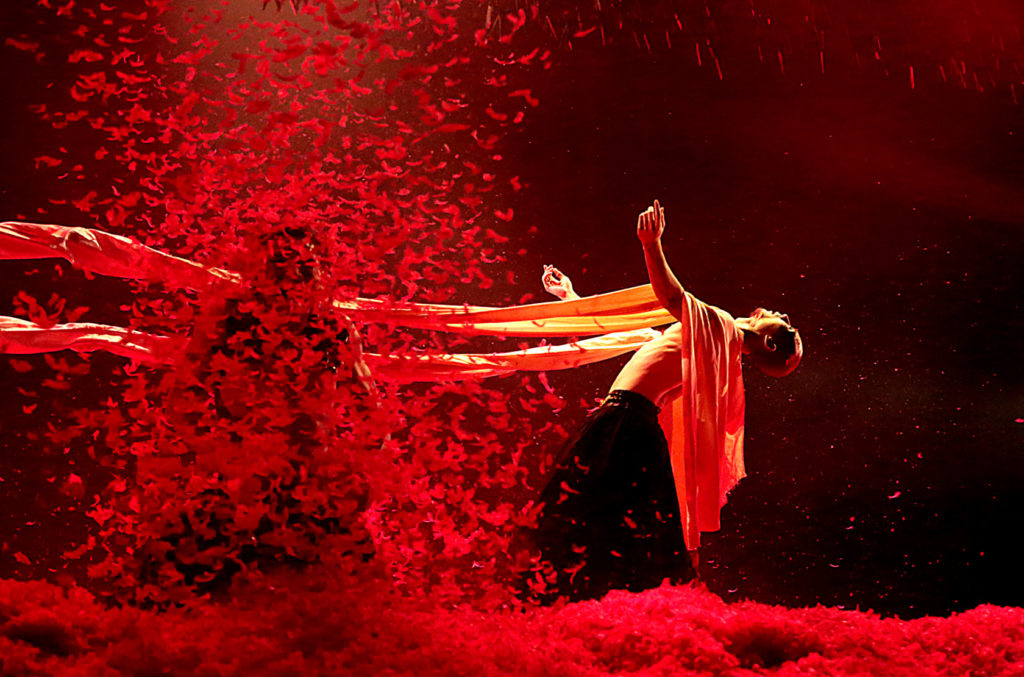
Yang Liping Contemporary Dance in Yang Liping’s (Photo: XIao Quan)
Yang has spoken of Pina Bausch’s influence on her work. Visually, this scene seemed to pay homage to Bausch’s Der Fensterputzer (The Window Washer) for which set designer Peter Pabst envisioned a mountain of bauhinia flowers. The crimson bauhinia is the official flower of Hong Kong; the piece was created for that city in 1997, the year of the Handover of the British colony to China. Red in China often symbolizes good fortune; in Der Fensterputzer it radiated happiness – and possibly Bausch’s wish for the future of Hong Kong. But in Under Siege, it appeared to represent cruelty.
Death finally came to our stoic Paper Cutter, too. Only once in the entire evening did she seem moved by the turn of events: during the climactic battle scene in which Liu would triumph over Xiang, she started frenziedly shredding paper and tossing it in the air – as if trying to alter the course of history which she had, until then, been calmly documenting. But as the body count from this senseless war mounted, she appeared to drown in a sea of text.
A metaphor perhaps for the fate of artists, scholars and ordinary citizens in a nation blanketed with propaganda.
As if to underscore the demise of history, one of the lighting rails that bore hundreds of open scissors was sent crashing to the stage behind Liu as he donned his fearsome crown.
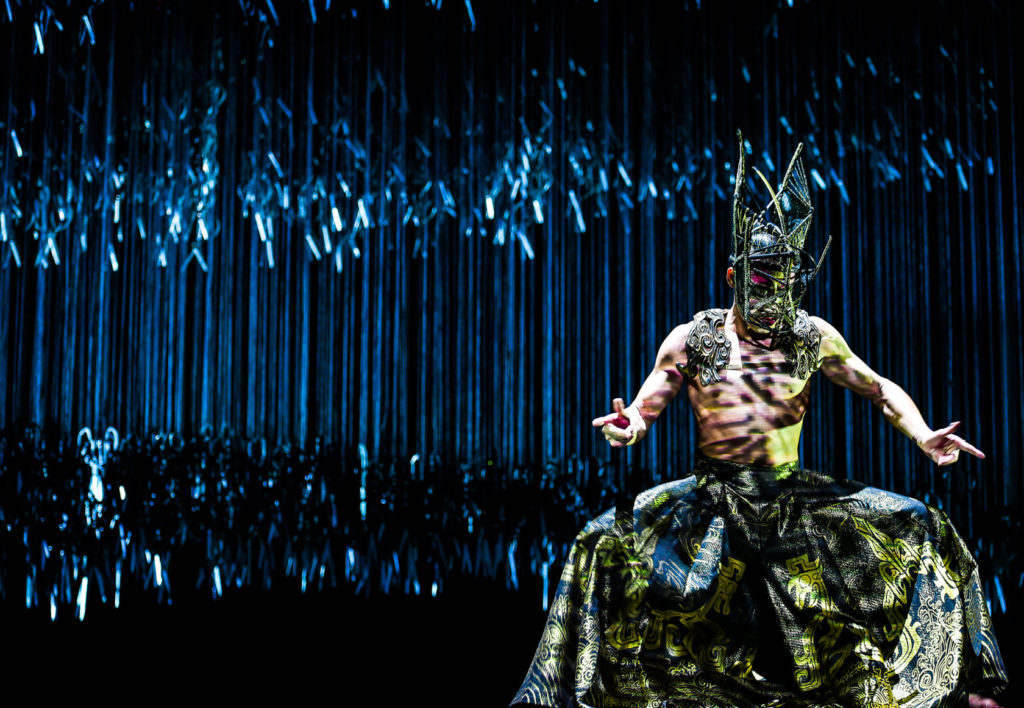
Yang Liping Contemporary Dance in Yang Liping’s (Photo: Ding Yi Jie)
– Carla Escoda reviewed Under Siege at the David H. Koch Theater on Thursday, Aug 8, 2019.





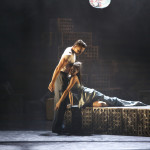

This dance has been performed a lot in China. The audience reaction is just focusing on history, they’re not connecting to what is happening today. Chinese people have a lot of pride in their ancient stories and ancient art but they should also open their eyes and see that what is going on today is not so different from the wars and the jealousy and the twisted stuff that went on 2000 years ago.
“Beijing, already grumpy over Donald Trump’s inability to grasp the basics of world trade, has accused the U.S. of masterminding massive street protests in Hong Kong.” – ha ha yes this is true
“Chinese propaganda arms have labeled the protests “terrorism” and whipped up public outrage on the mainland against the protestors.” – why is it when Chinese people are angry at the Hong Kong people this must be “propaganda”?
And WHY AM I READING THIS IN A REVIEW OF DANCE?
Carson, you’re reading this in a review of dance because all art is political.
A beautiful piece of historical art which you trashed with a political agenda.
Even the people of Hong Kong are disgusted with the protestors, they will be happy for the PLA to come in and teach them a lesson.
Ah Jimmy, have you seen this? https://www.vox.com/recode/2019/8/20/20813660/china-facebook-twitter-hong-kong-protests-social-media
Objections to political observations in an assessment of a work or a performance of one are absolutely appropriate. History impacts culture or it wouldn’t be culture–to wit–the synthesis of a thesis and an antithesis expressed through the medium of the Seven Lively Arts. Sadly, the Maoists and the anti-Mao cliques who used to be the “outs” and now are the “ins” are just as guilty of Stalinist demagogy as their predecessors and have given the word “propaganda”–a legitimate activity prior to Stalin’s reign and Mao’s mimetic version of it–a bad name. I suspect that the author would dis propaganda coming from the opposite side with equal vigor. I applaud her touching history, whether I happen to agree with her assessments or not. Critics must be objective about culture, but that is not the same as being neutral, because in the world we inhabit, there is no such thing as neutral. You must always ask of the person who claims to be neutral, “Is that so? Neutral on whose side?”